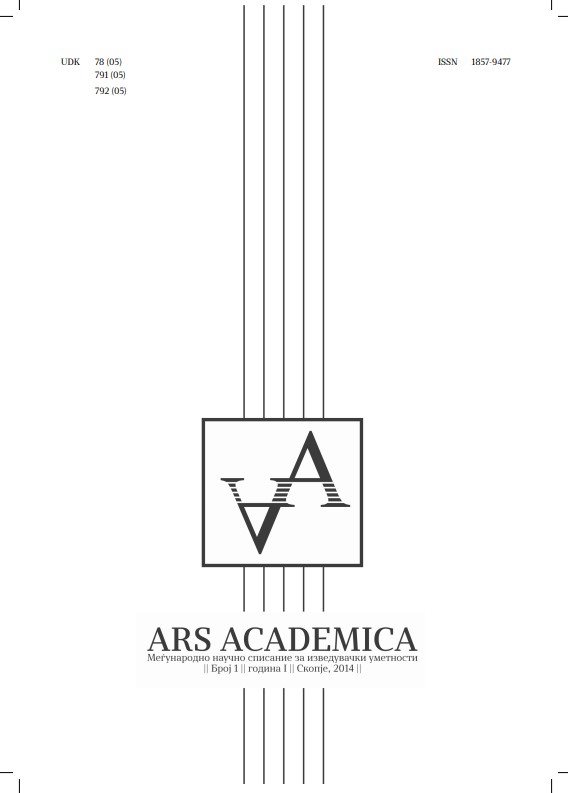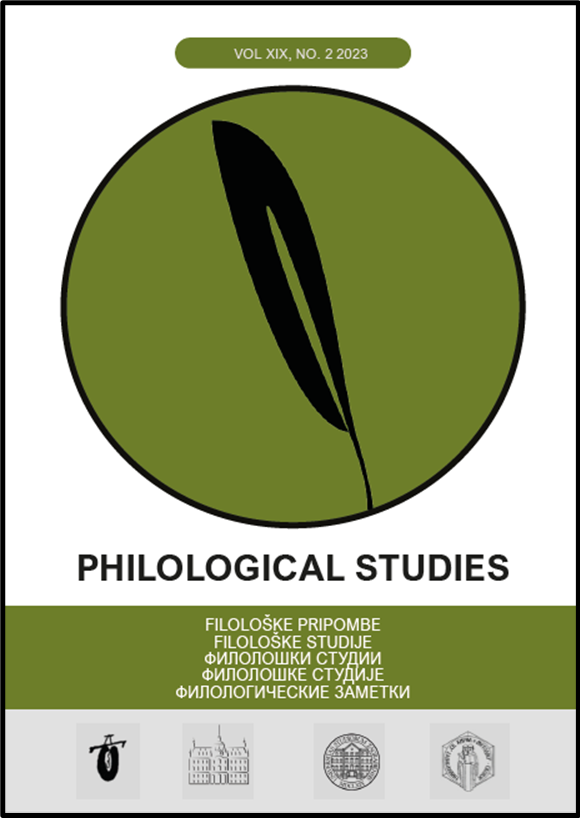Списанија
-
Аrs Academica
Научно-истражувачко списание за изведувачки уметности, единствено во оваа сфера во нашата земја. Неговата интердисциплинарна поставеност и третман на теми од областа на актерската игра, режијата, музикологијата, филмот, етномузикологијата, танцовата теорија, продукцијата, но и пeдагогијата, психологијата, историјата на уметноста итн., го зголемува читателскиот аудиториум и дава проширен опфат на темите кои се обработуваат.
Поле: перформативни уметности
-
ПЕДАГОШКА РЕВИЈА – научно списание за образовни прашања
Списанието обезбедува простор за претставување на најновите сознанија што се однесуваат на образовните прашања во најширока смисла.Следејќи го концептот на интегрален пристап во образовните процеси од една страна, списанието овозможува публикација на научни истражувања, студии на случај, компаративна анализа на теории, образовани системи и образовни политики, како и интердисциплинарни истражувања кои во својата основа ги имаат образовните процеси. Оттука и придонесот на трудовите за унапредување на воспитно-образовната теорија и практика како поле на дејствување.
-
Годишен зборник на Филолошкиот факултет „Блаже Конески“
Годишен зборник на Филолошкиот факултет „Блаже Конески“ е научно списание на Св. „Кирил и Методиј“ Универзитет во Скопје, Филолошкиот факултет „Блаже Конески“ во Скопје, кое се објавува еднаш годишно од 1975 година. Во него се застапени статии од областа на книжевноста и културата, јазикот и дидактиката, преведувањето и толкувањето, како и прикази на активностите на факултетот.
-
Религиски дијалог и соработка
The Journal Religious Dialogue and Cooperation is published by the Centrе for Intercultural Studies and Research at the Faculty of Philosophy at the Ss. Cyril and Methodius University in Skopje, which is conceived as an international scientific journal for all areas of religion. The journal publishes original scientific papers (statements from original empirical research on religion) and reviewed scientific papers (systematic reviews, analyses, processes, and interpretations of research findings and theoretical knowledge from a particular area of religion).
-
Iustinianus Primus Law Review
Iustinianus Primus Law Review е меѓународно, рецензирано, со отворен пристап, онлајн научно списание издадено од Правниот факултет „Јустинијан Први“ при Универзитетот „Св. Кирил и Методиј“ во Скопје, Република Северна Македонија. Нејзиниот прв том беше објавен во 2010 година.
-
Славистички студии
Славистички студии е меѓународно научно славистичко списание од областа на хуманистичките науки кое што го издава Катедрата за славистика при Филолошкиот факултет „Блаже Конески“ при Универзитетот „Св. Кирил и Методиј“ во Скопје.
-
Психологија: Наука и Практика
Списанието „Психологија: наука и практика“ е меѓународно научно-стручно списание за сите гранки на психологијата, во кое се објавуваат изворни научни трудови (соопштенија од оригинални емпириски истражувања), прегледни научни трудови (систематски прегледи, анализи, процени или толкувања на истражувачки наоди и теоретски сознанија од одделна област) и различни видови стручни прилози (соопштенија од конференции, извештаи од реализирани проекти, пленарни предавања, прикази, коментари, критички анализи, осврти и интервјуа).
Списанието го издава Институтот за психологија при Филозофскиот факултет на Универзитетот „Св. Кирил и Методиј“ во Скопје, Северна Македонија.
“Psychology: Science and Practice” is a peer-reviewed international journal that publishes research papers (reports from original empirical studies), review papers (systematic reviews, analyses, evaluations and interpretations of research results and theoretical insights from a specific field) and contributions (book reviews, critical analyses, brief reports from conferences and projects, commentaries and interviews).
The journal is published by the Institute of Psychology, Faculty of Philosophy at the Ss Cyril and Methodius University in Skopje, North Macedonia. -
Security Dialogues
Journal Security Dialogues (SD) е особено заинтересиран за трудови кои ги поврзуваат домашните и меѓународните политички прашања и случувања со националните и регионалните безбедносни грижи и импликации. Безбедноста се подразбира и во нејзината традиционална (на пр., меѓудржавни војни и конфликти, пролиферација на оружје, воена модернизација, градење сојузи, одбрана и надворешна политика, контрола на оружјето итн.) и нетрадиционална (на пр., слаби држави, граѓански војни, бунтовнички движења, етничко насилство, економска криза, социјални конфликти, демократски промени, транснационален тероризам, пиратерија, човечка безбедност итн.) сетила.
-
Ревија за социјална политика/Journal of Social Policy
Ревија за социјална политика/Journal of Social Policy е меѓународно рецензирано научно списание во издание на Филозофскиот факултет, Универзитет „Св. Кирил и Методиј“ во Скопје. Списанието има за цел да придонесе кон подигнување на критички јавни и академски дебати за прашања од социјалната политика, релевантни на локално, национално, регионално и меѓународно ниво. Списанието опфаќа теми поврзани со пазарот на трудот, животниот стандард, социјалната заштита, социјалното осигурување, образованието, здравството, долгорочната нега, домувањето, семејната политика, социјалната помош, социјалните трансфери, сиромаштијата и социјалната исклученост, антидискриминацијата итн.
-
Годишен зборник на Филозофски факултет - Скопје
Годишен зборник на Филозофски факултет - Скопје е списание кои се издава еднаш годишно за потребите на наставно-образовната и научната дејност на Филозофскиот факултет во Скопје и вообичаено со објавување на зборникот се обележува роденденот на факултетот. Зборникот се издава периодично од 1948 година до денес и во него е запишана најстарата научна работа во Македонија. Во него се публикуваат изворни и прегледни научни трудови , стручни прилози, прикази на конференции и книги, резимеа на докторски десертации, одбележувања на значајни годишнини, сеќавање за нечиј научен век итн.
-
Economy, Business and Development: An International Journal
Списанието „Економија, бизнис и развој“ (EB&D) се обидува да промовира разбирање на феномените на развојот од комбинирана перспектива на бизнис и економија. Списанието свесно се труди да ги комбинира научните перспективи релевантни за академските истражувања и политичките прашања поврзани со развојот. Во врска со ова, го користиме терминот развој нашироко - за да вклучиме стипендија за бизнис и економска перспектива во контекст на развиените и земјите во развој на микро или макро ниво. Исто така, прифаќаме истражувачки написи кои се фокусираат на една земја, но обезбедуваат генерализација што може да се користи во сличен емпириски контекст. Ги поздравуваме длабинските студии кои се користат за потврдување или проширување на постоечките теории и модели.
-
Journal of Contemporary Economic and Business Issues (Archived)
Списанието за современи економски и деловни прашања (JCEBI) повеќе не прифаќа ракописи. JCEBI од јуни 2020 година продолжува под новото име „Економија, бизнис и развој: меѓународен весник“. Веб-страницата на новото списание е https://journals.ukim.mk/index.php/ebd
-
Филолошки студии
Филолошки студии е меѓународно славистичко списание кое опфаќа широк опсег на истражувања од областа на филозофијата, литературата, историјата и лингвистиката преку следните рубрики: Филозофски и културни прашања; Историја и Филологија; „Зборови“ во историски и културен контекст (компаративни аспекти); Литературата во интеркултурен контекст; Современото општество во културата, јазикот и литературата; Говор, Лингводидактика; Прегледи и информации.
-
Journal of Contemporary Philology
Научното списание Современа филологија (СФ) е меѓународно електронско списание со двојно анонимно рецензирање, кое објавува висококвалитетни научни статии од областа на лингвистиката, применетата лингвистика, литературата и културолошките студии. Списанието има за цел да ги поттикне и да ги промовира истражувањата кои се однесуваат на теориски и на применети прашања, со посебен фокус на современите текови, на иновативните методологии и на интердисциплинарните пристапи.
СФ прифаќа оригинални трудови кои:
- обработуваат лингвистички, книжевни и културолошки аспекти;
- вклучуваат компаративна или контрастивна анализа;
- истражуваат клучни прашања од книжевната теорија и критика;
- се однесуваат на преведувањето и на меѓукултурната комуникација.Особено се добредојдени прилози што обработуваат теми од доменот на балканистичките и на славистичките студии.
Ги покануваме авторите да испраќаат претходно необјавени научни трудови, прегледни статии и рецензии на книги, напишани на англиски или на македонски јазик. Списанието излегува двапати годишно, со поддршка на Филолошкиот факултет „Блаже Конески“ при Универзитетот „Св. Кирил и Методиј“ во Скопје.
Indexed and abstracted in
- (Modern Language Association)
- (Directory of Open Access Journals)
- (UDK 81)
-
Journal of Agricultural, Food and Environmental Sciences, JAFES
Journal of Agricultural, Food and Environmental Sciences (JAFES) е меѓународно научно списание со отворен пристап, рецензирано од врсници, објавено двапати годишно. JAFES објавува оригинални истражувачки трудови фокусирани на сите аспекти на земјоделството, храната и еколошките науки, како што се: производство на растенија, заштита на растенијата, генетика, одгледување, генетски ресурси, биотехнологија, животинско производство, управување со вода, науки за почвата, земјоделска економија, рурален развој, информатичка технологија во земјоделството, прехранбена технологија, преработка на храна, квалитет и безбедност на храна и така натаму.
-
ЕтноАнтропоЗум
EthnoAnthropoZoom is a journal of the Institute of Ethnology and Anthropology at the Faculty of Natural Sciences and Mathematics at “Ss. Cyril and Methodius" University in Skopje. This journal focuses on articles belonging to the fields of ethnology, socio-cultural anthropology, linguistic anthropology, and theoretical anthropology, as well as articles belonging to related scientific disciplines. All published papers in the journal have been peer-reviewed by experts from corresponding fields from Macedonia and abroad.
The articles in the journal are published bilingually in Macedonian and English. Priority is given to domestic and foreign authors of original scientific articles that focus on ethnological and anthropological problems in Macedonia (separately or comparatively). Also eligible are original scientific texts that refer to the wider region of South-eastern Europe.
















